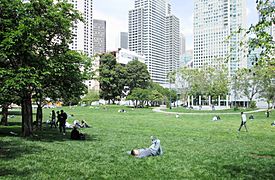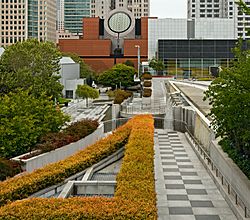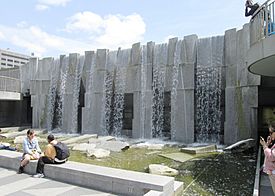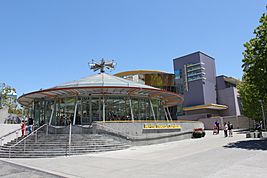Yerba Buena Gardens facts for kids
Quick facts for kids Yerba Buena Gardens |
|
|---|---|

(2017)
|
|
| Lua error in Module:Location_map at line 420: attempt to index field 'wikibase' (a nil value). | |
| Type | Urban |
| Location | South of Market, San Francisco, California |
| Nearest city | San Francisco |
| Created | 1993 |
| Operated by | San Francisco Redevelopment Agency |
| Open | All year |
| Status | Open |
Yerba Buena Gardens is the name for two blocks of public parks located between Third and Fourth, Mission and Folsom Streets in downtown San Francisco, California. The first block bordered by Mission and Howard Streets was opened on October 11, 1993. The second block, between Howard and Folsom Streets, was opened in 1998, with a dedication to Martin Luther King Jr. by Mayor Willie Brown. A pedestrian bridge over Howard Street connects the two blocks, sitting on top of part of the Moscone Center convention center. The Yerba Buena Gardens are owned by the San Francisco Redevelopment Agency and were planned and built as the final centerpiece of the Yerba Buena Redevelopment Area which includes the Yerba Buena Center for the Arts.
Yerba Buena was the name of the town in the Mexican territory of Alta California that became the city of San Francisco, California, after it was claimed by the United States in 1846. It was itself named after the yerba buena (Micromeria douglasii) plant which used to be abundant in the area. The plant's common name, yerba buena, is an alternate form of the Spanish hierba buena (meaning "good herb").
History
The idea of building a conference center, under the name Yerba Buena Center, in downtown San Francisco was a further development of the idea stemming from the late 1950s to redevelop the city center, particularly the industrial areas that were gradually falling into disuse. At the heart of the proposal was the vision of the city transforming from an industrial to a tourist-conventioneering city. The idea of the Yerba Buena Center itself first emerged in the early 1960s. At that time there was a concern about how development could occur in the downtown area. The South of Market area offered hundreds of acres of flat land at low land prices. Things changed with the election of a new city mayor, George Moscone, in 1976, who spearheaded construction. The Gardens was later built as part of a deal by Mayor Moscone with developers to "set aside land and funds for cultural institutions such as museums, exhibits, and theaters."
Critical acclaim and appraisal

In 1999 the Yerba Buena Gardens received the Gold Medal of the biannual Rudy Bruner Award for Urban Excellence. In praising the design of the work, the jury noted the process that led to the creation of the gardens, as well as its inclusiveness in terms of the population it serves and its neighborhood: "The mixed-use development enables cultural, social justice, and economic development agendas to coexist within a network of collaborative management practices." Furthermore, the jury "applauded the evolution of the project's development process to an inclusive model involving multiple constituencies." However, in his history of the development of San Francisco from the 1950s to the 1990s Chester Hartman recounts that the entire Yerba Buena project was long drawn out over 3 decades, born of a local struggle that included evictions and harassment of the previous tenants in the area, most of them old and poor, but who had joined together to fight for their rights. Even during the final design stages there were struggles regarding the building program. On hearing that the bowling alley was to be removed from the program, John Elberling, of the Tenants and Owners Development Corporation (TODCO), testifying at a San Francisco Development Agency (SFRA) hearing stated: "That's your fun, to go to gala openings at the Museum of Modern Art and the galleries, dress up in black tie and evening gowns, enjoy the boutique wines and rub shoulders with the City's social elite. But what about the kids of the central city?... A Redevelopment Agency that hands out free land for art museums for the wealthy in Yerba Buena but can't find funding for a bowling center too has no moral values..." Consequently, the SFRA backed down from its plan and the bowling alley was re-included and eventually built.
Public art
The original block opened in 1993 contains several public art installations. The Martin Luther King Jr. Memorial is located behind a large waterfall. The King memorial consists of large, etched glass excerpts of King's speeches in the languages of San Francisco's sister cities, and also includes a large green space where performance arts events are held throughout the year. The entire memorial was a collaborative project between Sculptor Houston Conwill, Poet Estella Majoza and Architect Joseph De Pace.
Conwill said the memorial is “a sacred space … meant to be experienced as a cultural pilgrimage and a journey of transformation.” The act of entering the Fountain from the Garden, reading of the text from North wall to East then, South Wall while beneath the water, then exiting back out into the garden, represents 'a cultural pilgrimage and contemplative metaphorical journey of transformation,' parallel to the Southern tradition of baptism by full immersion in water common within Old School Baptist churches like those of King's grandfather, legendary minister Adam Daniel Williams. On the terrace level above the waterfall is the Sister Cities Garden, where visitors can see an expertly manicured garden with plants representing each of San Francisco's sister cities, as well as a partial view of the downtown skyline.
Other attractions
Located in the Gardens proper are the Yerba Buena Center for the Arts, a contemporary arts center in the North block, and the Children's Creativity Museum (Zeum), a children's media and technology museum in the South block. An ice skating rink, a bowling alley, and a restored 1906 carousel by Charles I. D. Looff originally located at Playland-at-the-Beach can also be found in the South block. Eateries within the gardens include the B Restaurant and Grill and the Samovar Tea Lounge on the North block's terrace, Mo's Grill on the South block's upper walkway, and a snack shop by the carousel.
Nearby museums include: San Francisco Museum of Modern Art, Contemporary Jewish Museum, Museum of the African Diaspora, Children's Creativity Museum (Zeum), and formerly the Cartoon Art Museum. Other exhibiting institutions nearby include SF Planning and Urban Research Association and California Historical Society.
The Mexican Museum is (as of 2015) planned to be built across Mission Street as part the 53-story Yerba Buena tower, which will consist mostly of luxury condominiums. The project is planned to cost $500 million ($30 million of which for the museum) and will complete the "Yerba Buena district" redevelopment area, which apart from the Yerba Buena Gardens includes the Metreon and Moscone Center.
Located within two blocks of Yerba Buena Gardens are many hotels, museums, and retail centers. The St. Regis Museum Tower, W Hotel San Francisco, San Francisco Marriott, Four Seasons, and InterContinental Hotel San Francisco are some of the largest hotels in the area. Retail in the area include the Metreon bordering the North block, and the Westfield San Francisco Centre one block away in the old Emporium building, featuring San Francisco's first Bloomingdale's.



